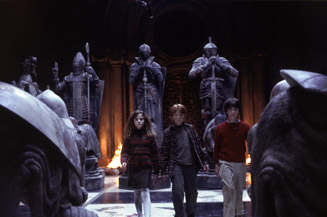|
|
Are You With Us?
|

|
This weekend, “In a hole in the ground lived a hobbit.” However, in 2001, another epic tale began with a similar line on a house on Privet Drive. While Warner Bros. is hoping to kick start a new trilogy based off the prequel to the wildly successful Lord of the Rings three-quel, the studio had immense luck over the 2001 pre-Thanksgiving weekend launching another all-ages franchise, Harry Potter and the Sorcerer’s Stone. Enjoying any chance to watch a Harry Potter film (being a fan of both the page and the screen versions) and given The Hobbit’s younger-aimed audience, I thought it would be valid to look back at the start of the Potter franchise and see how it holds up 11 years (and seven films) later.New at BOP: Share & Save
![]() Tweet
Tweet
![]() Print this column
Print this column
I was most surprised to see how young the actors were. Daniel Radcliffe, Rupert Grint, and Emma Watson were plucky children, certainly not the refined young adults we see covering magazines today.
A pop culture phenomenon that even those living under rocks have heard about, Harry Potter and the Sorcerer’s Stone is our introduction to the young wizards attending Hogwarts School of Witchcraft and Wizardry, focusing on the titular boy with the circular glasses and lightning bolt scar given to him after surviving a deadly curse by “He Who Must Not Be Named.”
While the world of Hogwarts is now commonplace to see on film, I am sure it must have been magical when I was nine-years-old, sitting in the theater, seeing the world that I had read about come to life. The first Quidditch match. The first spell cast. The first look at Hogwarts. I was just as spellbound by Potter’s onscreen adventures as his written ones.
|
Advertisement |
Unlike the more mature films that started on later in the series evolution, Sorcerer’s Stone is steeped in imaginative color layouts. The film focuses heavily on CGI, with director Chris Columbus taking time to showcase the different aspects of the castle, from talking paintings to moving staircases. The graphics take a co-starring role, being placed front and center rather than being a natural part of the magical world. While not a criticism, it is also not a compliment but rather a comment on the times. Still one month away from The Lord of the Rings: The Fellowship of the Ring being released, the intense CGI, which still holds up quite well today, was a spectacle that could have been a driving factor alone outside the name brand factor.
Screenwriter Steve Kloves (who has a screenwriter credit on all of the Potter films except The Order of the Phoenix) adapts the film with the utmost faithfulness to the book (or as similar one can get turning the page to screen), He says that he collaborated with author J.K. Rowling to get even minor details correct (and to not contradict the upcoming books, given that when the first film was released, only four out of the seven books were published).
Director Christopher Columbus and Warner Bros. also respected Rowling’s written word, agreeing to her terms of casting an all-British cast.
Continued:
1
2

|
|
|

|
Tuesday, May 21, 2024
© 2024 Box Office Prophets, a division of One Of Us, Inc.

